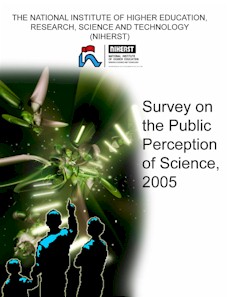
NIHERST has released the report on the Survey on the Public Perception of Science, 2005. This survey was designed to determine the information needs of the public and provide indicators of public attitudes towards science and included data on the level of scientific awareness and literacy; the sources, interest and consumption of information and the popularisation of science and scientific research in Trinidad and Tobago. In addition, information was obtained on several key social characteristics of respondents. The study also provides a benchmark against which changes in attitudes to science can be monitored over time.
In keeping with NIHERST's support for the overall development of science and technology in Trinidad and Tobago, this study aims to promote the measurement and analysis of public awareness and understanding of science for the purpose of guiding science and technology policy. This information can, therefore, assist researchers, decision-makers and science communicators in formulating and evaluating policies in science.
Summary of Main Findings
Data Highlights
- Of the total sample of 1595 respondents, 45% were males and 55% were females. The response to the survey was similar to the distribution of the population of Trinidad and Tobago by the age cohorts.
- Respondents expressed a substantial level of interest in religion (76%), sports (62%) and economics (58%). Forty five percent (45%) of the respondents sampled showed a high level of interest in science while 55% indicated little or no interest. Politics inspired the least degree of interest amongst respondents as 80% were 'a little interested' or 'not interested' in this area.
- A relatively large proportion of the survey respondents (74%) felt that they were informed with respect to science and technology while one quarter (26%) considered themselves not informed. The proportion of respondents who considered themselves informed about science and technology increased in relationship to educational attainment.
- The areas that inspired a high level of interest were: Medicine and health (82%), Environment (79%), Computers and IT (57%) and Agriculture (57%).
- The majority of respondents (91%) was of the opinion that scientific knowledge could improve one's ability to make decisions.
- Three quarters (75%) and more of the respondents with educational attainment indicated that scientific developments were beneficial to everyone. A substantial percentage (42%) of those with no educational attainment stated that the benefits of scientific developments would accrue to only a few individuals.
- The majority of respondents agreed with the statements: 'the government should increase investment in science and technology' (83%) and 'the benefits of science and technology are greater than the negative effects' (81%). On the other hand, a substantial percentage agreed that, 'society should use expenditure for science in more urgent activities' (73%).
- Over seventy five percent of the survey participants knew that 'high blood pressure is also called hypertension' (89%), 'plants produce oxygen' (87%), 'the centre of the earth is very hot' (79%) and 'light travels faster than sound' (79%); one half (53%) indicated it was not the mother's gene that decided the baby's gender.
- The majority of respondents (83%) was of the opinion that the media did not provide enough information on science; only 14% agreed.
- 'Television' was identified by 43% of the survey participants as their main source of science information, followed by books (19%) and newspapers (13%).
- Of the total respondents, two-thirds (68%) read the newspapers 'daily' or 'almost daily' while 27% were occasional 'once a week' or 'seldom' readers. However, only 15% read scientific articles 'regularly'.
- Less than half of the sample of respondents (43%) read books on science, while a substantial percentage (61%) never read science magazines and over forty percent (44%) never listened to science programmes on the radio. Of the respondents engaged in television viewing one quarter in each case accessed scientific information 'regularly' (24%) and 'once in a while' (26%).
- Most respondents (70%) did not use the internet as a source of information on science.
- One half of the survey participants (50%) agreed that the quality of science and mathematics education in our schools was adequate while a substantial 43% disagreed or strongly disagreed, especially amongst respondents with technical education (51%), bachelor's degree and above (48%), associate degree (47%) and commercial education (63%).
- Almost all of the respondents (92%) was of the opinion that food containing Genetically Modified Organisms (GMOs) should be so labelled.
- Approximately half of the respondents (48%) was aware of their blood type. The majority of respondents with higher levels of educational attainment knew their blood type, while those with primary (65%) and no educational attainment (83%) recorded the highest percentages where the blood type was not known.
- A relatively large proportion of the survey respondents (45%) was of the opinion that HIV/AIDS resulted from 'change in people's sexual habits', while two fifths were evenly divided between 'a scientist's experiment' (20%) and 'people's ignorance' (20%).
- Most of the survey participants (71%) were of the opinion that scientific and technological research was conducted in Trinidad and Tobago, especially amongst those informed on such activities. The majority of respondents (88%) who were of this view stated that such undertaking was useful.
- 'Government' was identified as the main source of research funding by over one half of the respondents (56%) who thought research was conducted locally.
- Only an extremely small percentage of the sample (3%) had participated in protest action or had made complaints about problems stemming from science and technology. However, the majority of respondents (87%) believed that it was important to take part in these issues.
- Overall, the participants of the survey demonstrated positive attitudes towards the subject of the enquiry. The majority (62%) stated that the study was 'interesting' and one quarter (24%) found it useful.






